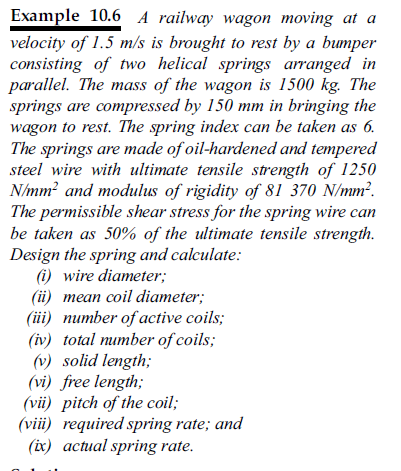Example 10.6 A railway wagon moving at a velocity of 1.5 m/s is brought to rest by a bumper consisting of two helical springs arranged in parallel. The mass of the wagon is 1500 kg. The springs are compressed by 150 mm in bringing the wagon to rest. The spring index can be taken as 6. The springs are made of oil-hardened and tempered steel wire with ultimate tensile strength of 1250 N/mm? and modulus of rigidity of 81 370 N/mm². The permissible shear stress for the spring wire can be taken as 50% of the ultimate tensile strength. Design the spring and calculate: (i) wire diameter; (i) mean coil diameter; (üi) number of active coils;
Example 10.6 A railway wagon moving at a velocity of 1.5 m/s is brought to rest by a bumper consisting of two helical springs arranged in parallel. The mass of the wagon is 1500 kg. The springs are compressed by 150 mm in bringing the wagon to rest. The spring index can be taken as 6. The springs are made of oil-hardened and tempered steel wire with ultimate tensile strength of 1250 N/mm? and modulus of rigidity of 81 370 N/mm². The permissible shear stress for the spring wire can be taken as 50% of the ultimate tensile strength. Design the spring and calculate: (i) wire diameter; (i) mean coil diameter; (üi) number of active coils;
Chapter2: Loads On Structures
Section: Chapter Questions
Problem 1P
Related questions
Question

Transcribed Image Text:Example 10.6 A railway wagon moving at a
velocity of 1.5 m/s is brought to rest by a bumper
consisting of two helical springs arranged in
parallel. The mass of the wagon is 1500 kg. The
springs are compressed by 150 mm in bringing the
wagon to rest. The spring index can be taken as 6.
The springs are made of oil-hardened and tempered
steel wire with ultimate tensile strength of 1250
N/mm? and modulus of rigidity of 81 370 N/mm?.
The permissible shear stress for the spring wire can
be taken as 50% of the ultimate tensile strength.
Design the spring and calculate:
(i) wire diameter;
(i) mean coil diameter;
(ii) number of active coils;
(iv) total number of coils;
(v) solid length;
(vi) free length;
(vii) pitch of the coil;
(vii) required spring rate; and
(ix) actual spring rate.
Expert Solution
This question has been solved!
Explore an expertly crafted, step-by-step solution for a thorough understanding of key concepts.
This is a popular solution!
Trending now
This is a popular solution!
Step by step
Solved in 4 steps

Knowledge Booster
Learn more about
Need a deep-dive on the concept behind this application? Look no further. Learn more about this topic, civil-engineering and related others by exploring similar questions and additional content below.Recommended textbooks for you


Structural Analysis (10th Edition)
Civil Engineering
ISBN:
9780134610672
Author:
Russell C. Hibbeler
Publisher:
PEARSON

Principles of Foundation Engineering (MindTap Cou…
Civil Engineering
ISBN:
9781337705028
Author:
Braja M. Das, Nagaratnam Sivakugan
Publisher:
Cengage Learning


Structural Analysis (10th Edition)
Civil Engineering
ISBN:
9780134610672
Author:
Russell C. Hibbeler
Publisher:
PEARSON

Principles of Foundation Engineering (MindTap Cou…
Civil Engineering
ISBN:
9781337705028
Author:
Braja M. Das, Nagaratnam Sivakugan
Publisher:
Cengage Learning

Fundamentals of Structural Analysis
Civil Engineering
ISBN:
9780073398006
Author:
Kenneth M. Leet Emeritus, Chia-Ming Uang, Joel Lanning
Publisher:
McGraw-Hill Education


Traffic and Highway Engineering
Civil Engineering
ISBN:
9781305156241
Author:
Garber, Nicholas J.
Publisher:
Cengage Learning